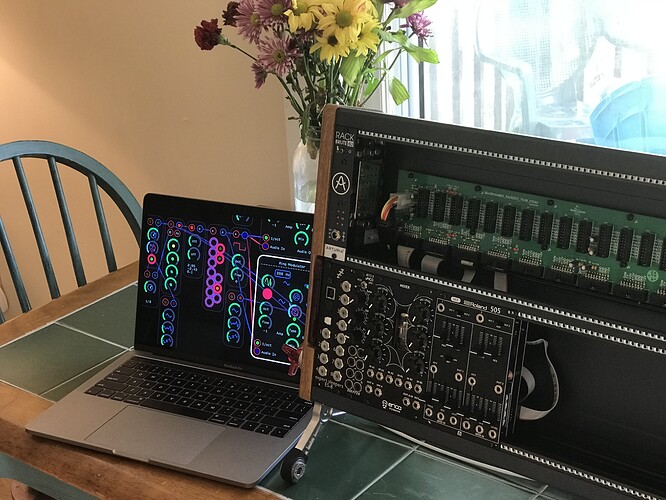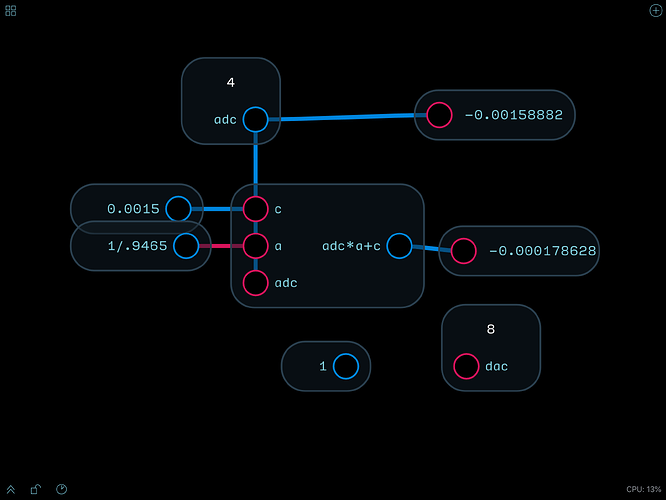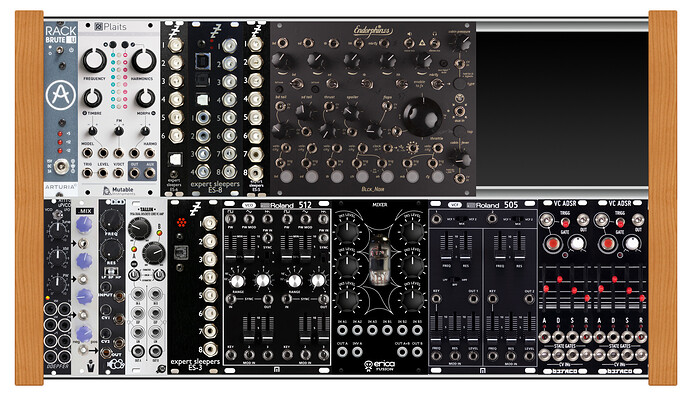The Xaoc stuff intrests me. Some of the “computing” is interesting. I think that sequencing is the elephant in the modular room. Their envelope module looks killer.
The ES-8 is amazing! I literally got one just to use with Audulus, so the videos you’ve done in the past have worked in that respect. (Just want to acknowledge that in case you felt like you hadn’t hit the mark.) That said, more ES-8 videos plz!!
Lots of good points made already. I like the video ideas you’ve gathered already. I think there’s room to do “instructional”/set-up time videos as well as more performance ones that take the viewer’s knowledge and enthusiasm into account, like what futureaztec mentioned.
I think you should pick up a few modules that are really popular, as that’s what’s going to catch a lot of people’s eye and open up Audulus to them. The Erica Pico Drums is one that immediately comes to mind. Just Audulus/ES-8/Pico Drum/maybe a filter… just whack it up with modulation/sequencing from Audulus. Rings is another good one.
I don’t know if you want to go down this route, but Audulus works amazingly with Eurorack video modules, specifically LZX Industries modules. These run on a -1/+1 modulation range but accept higher levels to accommodate Eurorack audio modules. The built in attenuators on the ES-8 module in Audulus are just perfect. I use Audulus A LOT to modulate video. I would be happy to make a video demonstrating it.
Other things I’d like to see touched on:
-The “infinite VCA” idea you mentioned earlier in this thread
-Using the inputs on ES-8 (admittedly I tend to only output from Audulus and haven’t explored the inputs)
-Instructional vs. Play videos (you’ve done this a bit already in the past. I think short, standalone play videos with minimal instruction/talking are really effective.)
-Using Audulus/ES-8 in conjunction with a more experimental system, not just sending v/Oct or modulating filters. Phonogene and two Noise Reap delays are the center of my system… Audulus allows me to do many different things within this framework.
I just made a nice module last night that helps you tune your VCOs more accurately using a spline. It’s actually pretty quick to use since I added some new features to it. My suspicion is that the ES-8 isn’t like a scientific-grade piece of equipment that exactly outputs a 1 to 1 representation of the voltage, and it needs some compensation to adjust. The Silent Way has a similar utility called the Voice Controller.
http://www.expert-sleepers.co.uk/silentway.html
I’ve observed it from just routing a patch cable out of the ES-8 and back in and measuring the voltage difference. I seem to remember @robertsyrett you having a similar issue. Anyway, I fixed it and now you can tune within your Audulus patch, create a “profile” for your oscillator (or even self-oscillating VCF that doesn’t have a VPO input), save that profile and use it to compensate when you’re driving it with sequences from Audulus.
I just need to make a better UI for it and I’ll be posting it today in a separate post.
It would be nice if there was a process someone like me could go through in order to have everything calibrated and whatnot.
The first time I ever saw a eurorack module in person was when it came in the mail a few months ago. The only people who know I have a modular are the people on this forum.
Your secret is safe with us 
same, and I’ve been using various modular systems for 8-9 years. never really needed to calibrate anything but I’ve always wondered how to do it, and what the results would yield.
if you’re looking for more modular info you could check out the muffwiggler forum (but as a disclaimer… stick to the main sections, there’s lots of BS in other parts of the forums. I spend less and less time there as time goes on. It does have a nice meetups/gatherings section though, you may be able to find something happening in your area.)
My measurements are that the outputs are less than 0.5% off of perfect -10V to 10V scaling. This means that the intuitive math works just fine.
Inputs are not as spot on. I use the following formula ADC*α + c, where ADC is the channel input, α is the scalar (scaler?), and c is the constant offset.
You can calculate the c just by making an ADC node pointed at an ES-8 channel with nothing connected to it and taking the inverse. It is important there is no cable connected to the relevant input.
In the above example, the adc is steady at -.0015 while after that we hit the noise floor which is flusuating. So the c value is .0015.
The α is calculated by routing a value of 1 out the ES-8 through a DAC node and back into the ES-8 on the channel you were using and taking the reciprocal.
And by that point I am back to less than 1% error for incoming pitch CV.
This is similar on mine - it’s probably more the oscillator, but if you don’t tune them, the oscillator I play in my system will diverge from an Audulus oscillator I’m mixing in.
With the (o+4)/10 have you just used your system’s oscillators or have you had a similar problem I’ve had?
The deviation in volts is small for me but it ends up making a big difference to the oscillator especially the higher up it goes.
Tracking definitely varies from oscillator to oscillator. Makenoise and Mutable oscillators track nearly perfectly. Intellijel is a little wacky, but they have an octave switch built into the oscillators. AJH and Noise Reap, you definitely need to dial in the range you are interested in because I don’t think they have high end tracking compensation across 10 octaves, but I can just shift the octave down in audulus to keep things in the sweet spot of linearity. I sometimes have to do a little tuning by ear before I am satisfied, but that’s perfectly fine for me.
Were you able to try this module out? Were the instructions clear enough inside? I’m going to make a video with this thing so if people don’t understand it they will once they watch.
I did download it, I will have to wait to try it out until Monday when I get back home. I looked inside and the only thing I thought could use clarification how the signals were routed. It might be good to have a SVG with a simple line diagram to show the patching. A video will definitely help as well, get filming! 






Yeah I’ll definitely document it inside the module too, but making a diagram is a great idea!
Just ordered a Plaits! I can see what @robertsyrett was saying about sequencing the modes - really psyched to get videos going for that.
This is what I was daydreaming about tonight while watching Riverdale season 2…not sure what to put in the blank spot. Maybe Maths and some Distings? Any ideas? I can’t have any more voices since I’m pretty maxed out on CV outputs.
There’s basically 4 main voices in this rig: Plaits (for chords mostly, but also other bleeps and bloops), Black Noir for Drums, uPVCO, etc for lead or bass, Roland 512 etc. for another analog voice.
Anyway, this way it’s wired up, I will be able to control everything from Audulus on iPad and do mixing/muting/sequencing during performance.
Basically Audulus would act as the sequencer, modulation source, mixer, and some effects (and maybe some bonus voices, especially when sampling comes out - who knows).
The ES-5 takes two of the ES-8’s channels and turns them into gates. I might have to lose the PWM and second oscillator tracking outputs from ES-3 on the Roland 512 oscillator to have stereo output (since iPad can’t do aggregate devices like a computer can).
Maths and maybe a wavefolder like Bastl Timbre or a disting mk 4 with midi breakout could be good.




